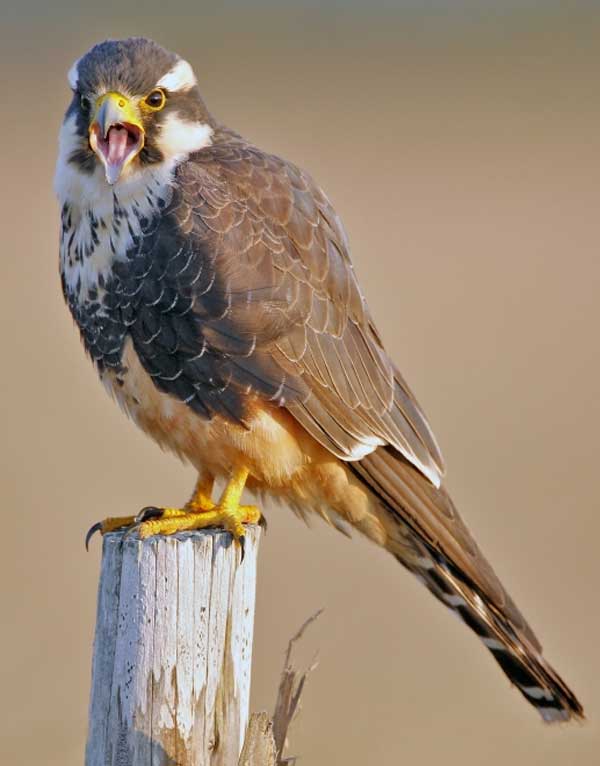Falco femoralis (www.naturespicsonline.com) Cladus: Eukaryota Name Falco femoralis Temminck, 1822 Reference Nouveau recueil de planches coloriées d'oiseaux livr.21 pl.121,text; 1825 livr.58 pl.343,text Vernacular names ---------- The Aplomado Falcon, Falco femoralis, is a medium-sized falcon of the Americas. The species' largest contiguous range is in South America, but not in the deep interior Amazon Basin. It was long known as Falco fusco-coerulescens or Falco fuscocaerulescens, but these names are now believed to refer to the Bat Falcon (F. rufigularis)[1]. Its resemblance in shape to the hobbies accounts for its old name Orange-chested Hobby. Aplomado is an unusual Spanish word for "lead-colored", referring to the blue-grey areas of the plumage – an approximate English translation would be "leaden falcon". Spanish names for the species include halcón aplomado and halcón fajado (roughly "banded falcon" in reference to the characteristic pattern); in Brazil it is known as falcão-de-coleira. The Aplomado Falcon is very slender, long-winged, and long-tailed, the size of a small Peregrine Falcon (F. peregrinus), at 12–16 in (30–40 cm) long and with an average wingspan of about 36 in (90 cm), but only half the weight, at about 7.3–10.8 oz (208–305 g) in males and 9.6–16 oz (271–460 g) in females[2]. In adult birds, the upperparts are dark blue-grey, as is much of the head, with the usual falcon "moustache" contrasting sharply with the white throat and eyestripe. The upper breast continues the white of the throat; there are black patches on each side of the lower breast that meet in the middle; the belly and thighs, below the black patches, are light cinnamon. The tail is black with narrow white or grey bars and a white tip. The cere, eye-ring, and feet are yellow or yellow-orange.[3] Except that females are bigger than males, the sexes are similar. Juvenile birds are very similar to adults, but their upperparts and belly band are blackish brown, the chest is streaked with black, the white on the head and breast is buffy, and the cinnamon on the underparts is paler, as are the feet.[3] This species may be confused with the Bat Falcon (F. rufigularis) and the Orange-breasted Falcon (F. deiroleucus), which have similar white-black-rust patterns below, but those species are built more like Peregrine Falcons and have solidly blackish heads and darker rufous bellies.[3] These two species are generally considered to belong to the same lineage as the Aplomado Falcon. Two other Falco species of the Americas, Merlin (F. columbarius) and American Kestrel (F. sparverius), seem to be closer to the Aplomado group than most other falcons, but the relationships of all these lineages are fairly enigmatic. All that can be said with some certainty is that they diverged as part of an apparently largely western Holarctic radiation in the Late Miocene, probably around 8–5 million years ago.[4] Range, ecology and status The Aplomado Falcon's habitat is dry grasslands, savannahs, and marshes. It ranges from northern Mexico and Trinidad locally to southern South America, but has been extirpated from many places in its range, including all of northern and central Mexico except for a small area of Chihuahua. Globally, however, it is so widespread that it is assessed as Species of Least Concern by the IUCN[5]. It feeds on large invertebrates and small vertebrates, with small birds making up the overwhelming bulk of its prey. Mixed-species feeding flocks in open cerrado and grassland will go on frenzied alert upon spotting this species; small birds fear it more than most other predators[6]. It is often seen soaring at twilight hunting insects and eating them on the wing[3]. It also hunts at fields being burned, at which many birds of this species may gather; cooperation between individual Aplomado Falcons – usually members of a pair – has also been recorded. In Brazil, Aplomado Falcons have been observed following Maned Wolves (Chrysocyon brachyurus) and chasing birds that the wolves flush[7]. Prey items typically weigh one-fifth to one-half of the falcons' own weight, but females of this species (which due to their size can tackle larger prey) have been recorded eating birds larger than themselves, such as a Cattle Egret (Bulbucus ibis) or a Plain Chachalaca (Ortalis vetula), on rare occasions.[2] Until the 1950s it was found in the extreme southwestern United States, and reintroduction efforts are under way in Western and Southern Texas. It began to reoccupy its former range in West Texas and southern New Mexico in the 1990s[8]. Documentary evidence for these naturally occurring birds was obtained in New Mexico in 1991, and sightings built steadily through that decade and the next, leading to successful fledging of three young in 2002[9]. Sightings and nesting activity continue to the present. The expansion of the reintroduction program to that area has met with criticism, because technically, all Aplomado Falcons in New Mexico are classified as part of the "experimental" (reintroduction) population[10]. As such, while they are still legally protected from hunting, they are not protected by Endangered Species Act requirements to preserve habitat and the like. It is believed that mainly habitat destruction caused the species' (near-)disappearance from the US and hinders reestablishment of a wild breeding population. A coalition of environmental groups is attempting to have full protection restored so as not to jeopardize the success of the expanding wild population and the reintroduction efforts[11]. In Falconry Footnotes 1. ^ AOU (1948)
* Albuquerque Journal (AJ) (2008): Federal Judge in N.M. To Consider Legality of Falcon Decision. Version of 2008-MAY-21. Retrieved 2008-SEP-21.
Source: Wikispecies, Wikipedia: All text is available under the terms of the GNU Free Documentation License |
|

